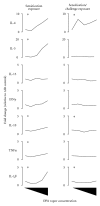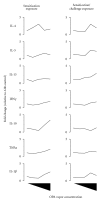Inhalation of ortho-phthalaldehyde vapor causes respiratory sensitization in mice
- PMID: 21785612
- PMCID: PMC3137992
- DOI: 10.1155/2011/751052
Inhalation of ortho-phthalaldehyde vapor causes respiratory sensitization in mice
Abstract
Ortho-Phthalaldehyde (OPA) has been approved for high-level sterilization of heat-sensitive medical instruments and is increasingly being used as a replacement in the healthcare industry for glutaraldehyde, a known sensitizer. Numerous case reports have been published indicating workers and patients experiencing respiratory problems, anaphylaxis, skin reactivity, and systemic antibody production. Our laboratory previously demonstrated that OPA is a dermal sensitizer in mice. The goal of the present study was to determine if OPA is a respiratory sensitizer following inhalation exposure. Mice were exposed to OPA vapor and airway and lymph nodes were examined for cytokine gene expression and alterations in lymphocyte populations. Inhalation of OPA for 3 days resulted in a concentration-dependent increase in lymphocyte proliferation, mainly B lymphocytes, in the draining lymph nodes. A secondary challenge of mice with OPA resulted in a dramatic increase in the population of B lymphocytes expressing IgE. Expression of Th2 (IL-4, IL-5, and IL-13) and anti/proinflammatory (IL-10, TNFα, and IL-1β) cytokine genes was upregulated in the lymph nodes and the nasal mucosa. Mice exposed to the higher concentrations of OPA-produced OPA-specific IgG(1) antibodies indicating systemic sensitization. These findings provide evidence that OPA has the potential to cause respiratory sensitization in mice.
Figures






Similar articles
-
Prior Exposure to Ortho-Phthalaldehyde Augments IgE-Mediated Immune Responses to Didecyldimethylammonium Chloride: Potential for 2 Commonly Used Antimicrobials to Synergistically Enhance Allergic Disease.Toxicol Sci. 2020 Nov 1;178(1):127-137. doi: 10.1093/toxsci/kfaa112. Toxicol Sci. 2020. PMID: 32647894 Free PMC article.
-
Evaluation of the respiratory tract toxicity of ortho-phthalaldehyde, a proposed alternative for the chemical disinfectant glutaraldehyde.Inhal Toxicol. 2017 Aug;29(9):414-427. doi: 10.1080/08958378.2017.1390015. Epub 2017 Oct 17. Inhal Toxicol. 2017. PMID: 29039228
-
Irritancy and allergic responses induced by topical application of ortho-phthalaldehyde.Toxicol Sci. 2010 Jun;115(2):435-43. doi: 10.1093/toxsci/kfq054. Epub 2010 Feb 22. Toxicol Sci. 2010. PMID: 20176622 Free PMC article.
-
Allergy to ortho-phthalaldehyde in the healthcare setting: advice for clinicians.Expert Rev Clin Immunol. 2013 Mar;9(3):227-34. doi: 10.1586/eci.12.107. Expert Rev Clin Immunol. 2013. PMID: 23445197 Review.
-
Evidence-based decision making in an endoscopy nurse with respiratory symptoms exposed to the new ortho-phthalaldehyde (OPA) disinfectant.Occup Med (Lond). 2005 Oct;55(7):575-8. doi: 10.1093/occmed/kqi119. Occup Med (Lond). 2005. PMID: 16251378 Review.
Cited by
-
The role of lymphocyte proliferation tests in assessing occupational sensitization and disease.Curr Opin Allergy Clin Immunol. 2012 Apr;12(2):102-10. doi: 10.1097/ACI.0b013e3283511396. Curr Opin Allergy Clin Immunol. 2012. PMID: 22306552 Free PMC article. Review.
-
Prior Exposure to Ortho-Phthalaldehyde Augments IgE-Mediated Immune Responses to Didecyldimethylammonium Chloride: Potential for 2 Commonly Used Antimicrobials to Synergistically Enhance Allergic Disease.Toxicol Sci. 2020 Nov 1;178(1):127-137. doi: 10.1093/toxsci/kfaa112. Toxicol Sci. 2020. PMID: 32647894 Free PMC article.
-
Occupational Respiratory Allergic Diseases in Healthcare Workers.Curr Allergy Asthma Rep. 2016 Nov;16(11):77. doi: 10.1007/s11882-016-0657-y. Curr Allergy Asthma Rep. 2016. PMID: 27796792 Review.
-
Asthma Phenotypes and Host Risk Factors Associated With Various Asthma-Related Outcomes in Health Workers.Front Allergy. 2021 Oct 15;2:747566. doi: 10.3389/falgy.2021.747566. eCollection 2021. Front Allergy. 2021. PMID: 35386991 Free PMC article.
References
-
- Curran AD, Burge PS, Wiley K. Clinical and immunologic evaluation of workers exposed to glutaraldehyde. Allergy. 1996;51(11):826–832. - PubMed
-
- Di Stefano F, Siriruttanapruk S, McCoach J, Burge PS. Glutaraldehyde: an occupational hazard in the hospital setting. Allergy. 1999;54(10):1105–1109. - PubMed
-
- Di Stefano F, Siriruttanapruk S, McCoach JS, Burge PS. Occupational asthma due to glutaraldehyde. Monaldi Archives for Chest Disease. 1998;53:50–55. - PubMed
-
- Maier LE, Lampel HP, Bhutani T, Jacob SE. Hand dermatitis: a focus on allergic contact dermatitis to biocides. Dermatologic Clinics. 2009;27(3):251–264. - PubMed
LinkOut - more resources
Full Text Sources
